East Coast Encounters 1770
The notion that Cook represents the clash of an ancient culture with a rising empire is the centralising theme of this collection of ten essays.
READ REVIEW
↓
East Coast Encounters 1770: Reflections on a cultural clash
Pauline Curby (co-ordinating editor) | Launched April 2020
James Cook embodies the spirit of 18th century British imperialism. His charting of the east coast of the legendary Great Southern Land was a turning point in the continent’s long history and heralded its colonisation. As the title East Coast Encounters 1770: Reflections on a cultural clash suggests, the notion that Cook represents the clash of an ancient culture with a rising empire is the centralising theme of this collection of ten essays. Most of the papers examine the history behind these encounters from various points of view and cover a range of issues, including Cook’s early career and skills as an envoy to the Pacific nations, the empire-building forces behind Cook’s first voyage into the Pacific, Indigenous reactions to his arrival in their country, and how Cook has been remembered.
The authors of the papers come from diverse backgrounds, ranging from local historians, to academics, to museum curators and library research officers. All offer fresh views on rehashed topics. For example, rather than focusing on the violent encounter at Botany Bay, the paper that presents an Indigenous perspective on Cook’s actions, ‘Warrawarrawa ‒ What was really said to Cook’, delves into possible meanings of the only recorded words uttered by two Aboriginal men about the landing party (pp. 74-82).
Two of the papers cover topics rarely mentioned. ‘Two Many Captain Cooks’ (pp. 84-91) looks at Cook memorabilia housed in the National Maritime Museum and ‘Remembering Forby Sutherland’ (pp. 52-57) throws a spotlight on a forgotten player in the Captain Cook saga, Forby Sutherland, a seaman who died at Botany Bay on 2 May, 1770.
Each paper is lavishly illustrated. Some are interspersed with panels that serve as extended footnotes on related topics, such as the problem of scurvy on the Endeavour and Beaglehole’s role as Cook’s biographer.
The book is top and tailed by essays on Cook’s two landing sites. Pauline Curby’s potted history of the Cook landing site in Dharawal country traces the changes that took place on the Kurnell Peninsula as it developed from an isolated farming village into an industrial site during the 1950s. Woven into the history is an overview of the ongoing community activism aimed at preserving both the native flora and fauna of the peninsula and its historic significance. Mark McKenna’s history of Cook’s enforced stay near Cooktown provides a detailed account of Cook’s encounters with the Guugu Yimithirr people. Like Curby, McKenna mentions how Cook’s landing has been commemorated in Cooktown and concludes with an analysis of the debates about Cook’s place in Australian history that erupt every year over Australia Day celebrations.
The introduction to the book states that the motive of the Sutherland Shire Historical Society for publishing it was to acknowledge the ‘Dharawal people and their role in the meeting of two cultures in 1770’ (p. x) and claims it to be ‘a new assessment of the extraordinary events from the perspective of both Europeans and Aboriginal people’ (p. xi). It certainly lives up to these claims.
Reviewer: Dr Chris Cheater, PHA (Vic & Tas)
East Coast Encounters 1770 can be ordered online at https://www.shirehistory.org
$35 per book, plus $10 postage and handling (includes up to five books)

